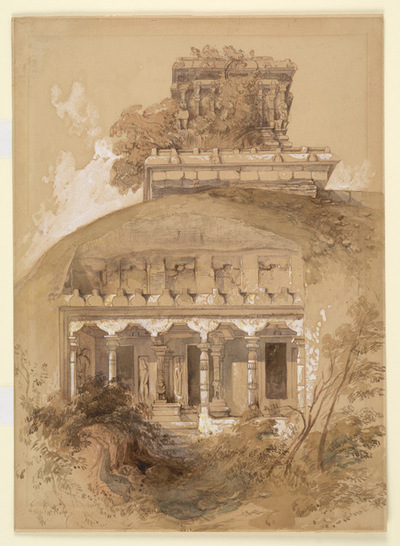Javascript must be enabled to continue!
Front view of Mahishamardani cave, Mahabalipuram
View through Europeana Collections
Watercolour of the Mahishamardani cave in
Mamallapuram, Tamil Nadu, Thomas Colman Dibdin (1810-1893),
c.1845.This drawing is for Dibdin's lithograph which was reproduced
as plate 17 in J. Fergusson's 'Illustrations of the rock cut
temples of India', published in London in 1845. Mamallapuram, a
tiny village south of Chennai (Madras), was a flourishing port of
the Pallava dynasty from the 5th - 8th centuries. The site is
famous for a group of temples, a series of rock-cut caves and
monolithic sculptures that were most likely created in the 7th
century reign of Narasimhavarman Mahamalla. The caves are all
fronted with fine columns resting on seated lions, typical of the
Pallava style. This view depicts the Mahishamardini Cave Temple
which consists of a long verandah with fluted columns and three
shrines. It is famous for the large sculpture panels on the side
walls of the shrines, considered among the masterpieces of Pallava
art.
Title: Front view of Mahishamardani cave, Mahabalipuram
Description:
Watercolour of the Mahishamardani cave in
Mamallapuram, Tamil Nadu, Thomas Colman Dibdin (1810-1893),
c.
1845.
This drawing is for Dibdin's lithograph which was reproduced
as plate 17 in J.
Fergusson's 'Illustrations of the rock cut
temples of India', published in London in 1845.
Mamallapuram, a
tiny village south of Chennai (Madras), was a flourishing port of
the Pallava dynasty from the 5th - 8th centuries.
The site is
famous for a group of temples, a series of rock-cut caves and
monolithic sculptures that were most likely created in the 7th
century reign of Narasimhavarman Mahamalla.
The caves are all
fronted with fine columns resting on seated lions, typical of the
Pallava style.
This view depicts the Mahishamardini Cave Temple
which consists of a long verandah with fluted columns and three
shrines.
It is famous for the large sculpture panels on the side
walls of the shrines, considered among the masterpieces of Pallava
art.
Related Results
General view of cave temples in the Barabar Hills, Gaya
(Bihar). January 1814
General view of cave temples in the Barabar Hills, Gaya
(Bihar). January 1814
Water-colour of the cave temples in the Barabar
Hills, at Gaya in Bihar, dated January 1814. Inscribed on front in
ink: 'View of the Rock of the Caverns at - mile from Ghya.' '
Jan...
Entrance to the cave temple of Karle. Copy of an original
sketch of 1805
Entrance to the cave temple of Karle. Copy of an original
sketch of 1805
Water-colour by James Broff Byers of the entrance
to the cave temple of Karle, dated 1815. Inscribed on reverse:
'View of the Entrance, or External Appearance of the magnificent
Ca...
Cave 1, Details of Pillars f.30
Cave 1, Details of Pillars f.30
Pencil drawing of pillars from Cave 1 at Ajanta,
from an Album of 26 ground plans of the Ajanta caves and 16 folios
of drawings of sculpture and architectural details in the Ajanta...
Cave 1, Details of Pillars f.33
Cave 1, Details of Pillars f.33
Pencil drawing of pillars and pilasters from Cave
1 at Ajanta, from an Album of 26 ground plans of the Ajanta caves
and 16 folios of drawings of sculpture and architectural details...
Cave 1, Details of Pillars f.34
Cave 1, Details of Pillars f.34
Pencil drawing of pillars from Cave 1 at Ajanta,
from an Album of 26 ground plans of the Ajanta caves and 16 folios
of drawings of sculpture and architectural details in the Ajanta...
View from the left of the great horseshoe window over the
entrance of Buddhist chaitya hall, Cave IX, Ajanta
View from the left of the great horseshoe window over the
entrance of Buddhist chaitya hall, Cave IX, Ajanta
Stereoscopic photograph of the façade of the
Buddhist Cave 9 at Ajanta taken by Robert Gill in 1868. The
Buddhist cave temples of Ajanta were excavated into a horse-shoe
shaped cl...
illustration; print (art)
illustration; print (art)
Two illustrations of Landscape Scene. The painting at the bottom illustrates part of the Lotus Sutra (Fahuajing) in Cave 112. Copied from mural paintings in Cave 172 (top) and Cave...
Ajanta: Cave XVII. Painting in the verandah
Ajanta: Cave XVII. Painting in the verandah
Illustration of the painting in the verandah from
the Buddhist vihara, Cave XVII at Ajanta, from James Burgess'
'Original Drawings from the Buddhist Rock Temples at
Ajanta.'Â The B...




